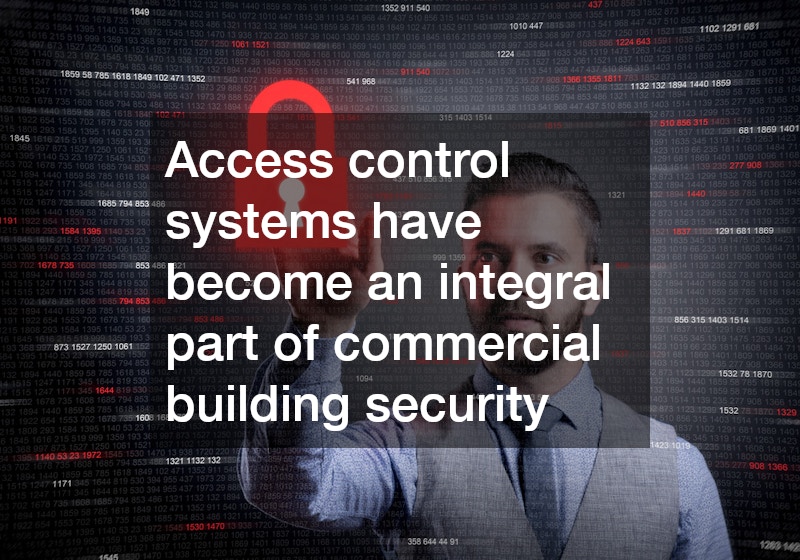Securing a commercial building has become increasingly complex in recent years, with property owners seeking smarter and more efficient ways to protect their facilities. One of the most effective advancements in modern building security is the use of access control systems. These systems are designed to manage and monitor who enters or exits a property, creating a robust layer of protection beyond traditional locks and keys. As threats evolve and businesses place a greater emphasis on safety, access control systems have adapted to meet the demands of 21st-century security challenges.
How Do Access Control Systems Improve Security in Commercial Buildings?
Understanding Basic Security Features
At their core, access control systems are designed to regulate entry points throughout a commercial property. Whether it’s a main entrance, server room, or restricted workspace, these systems give building administrators the ability to permit or deny access to individuals based on credentials.
Typically, a system includes electronic locks, credential readers, control panels, and software that logs all entry activity. This real-time tracking not only deters unauthorized entry but also provides valuable data should a security incident occur.
Implementing Access Protocols
Beyond simply allowing or denying entry, access control systems are highly customizable. Administrators can set up different access levels based on job roles or security clearance. For example, employees in human resources may have access to one area, while IT professionals may be allowed into server rooms. This segmentation of access minimizes the risk of internal threats and ensures that sensitive areas are protected at all times. Additionally, time-based protocols can be implemented to limit access outside of working hours, enhancing overall building security.
What Types of Access Control Systems Are Available?
Card-Based Systems
Card-based access control systems remain one of the most commonly used options in commercial settings. These systems require individuals to swipe or tap an identification card or fob against a reader to gain entry. Over time, card-based systems have evolved to incorporate encrypted data and integrate with broader security networks, including surveillance and alarm systems. While traditional in design, these systems continue to offer a reliable and straightforward solution for businesses of all sizes.
Biometric Access Control
As technology has advanced, so too have the capabilities of access control systems. Biometric solutions—such as fingerprint scanning, iris recognition, and facial recognition—have emerged as high-security alternatives to card-based systems. These methods rely on unique physical traits, which are difficult to duplicate or steal. Biometric access control systems offer heightened accuracy and accountability, ensuring that only authorized individuals are granted entry. They’re instrumental in high-risk environments such as research labs, data centers, or financial institutions.
How to Choose the Right Access Control System for Your Building?
Assessing Building Needs and Security Levels
Every commercial building has its own set of security requirements. Before implementing access control systems, it’s important to conduct a thorough assessment of your facility. Consider the number of entry points, the types of individuals requiring access, and the level of sensitivity associated with various areas. This evaluation helps determine which system configuration, whether card-based, biometric, or mobile app-based, is most suitable for your property.
Consulting with Security Experts
Working with a professional security consultant can significantly ease the process of selecting and installing access control systems. Experts are well-versed in the latest technologies and compliance standards, and can recommend solutions tailored to your specific business goals. They also help ensure that systems are correctly integrated with other building infrastructure and that staff are trained to use the technology effectively. Involving a professional ensures that your system performs optimally from day one.
Are There Any Legal or Privacy Concerns with Access Control?
Understanding Local Laws and Regulations
While access control systems are powerful tools for enhancing security, they must be implemented by local, state, and federal regulations. Depending on your location and industry, there may be specific laws governing how access is managed and monitored. For example, data collected from these systems—such as entry logs—must be stored securely and accessible only to authorized personnel. Ensuring compliance is essential to avoid legal complications and protect your organization’s reputation.
Data Privacy and Protection
Because many access control systems collect personal information—including biometric data—it’s critical to implement safeguards that protect user privacy. This includes encrypting stored data, using secure authentication methods, and establishing clear policies on how information is handled. Businesses should be transparent about what data is collected, who has access to it, and how long it’s retained. Prioritizing privacy not only protects employees and visitors but also fosters trust within your organization.
Final Thoughts
Access control systems have become an integral part of commercial building security, offering advanced tools to regulate and monitor access with precision. From traditional card readers to cutting-edge biometric solutions, these systems provide the flexibility, efficiency, and protection modern businesses need. By carefully assessing your building’s needs, consulting with experts, and adhering to legal and privacy standards, you can implement an access control solution that enhances security while supporting daily operations.




